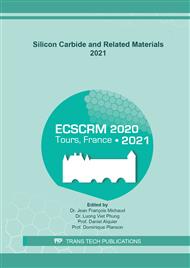[1]
T. Kimoto, J.A. Cooper, Fundamentals of Silicon Carbide Technology, John Wiley & Sons Singapore Pte. Ltd, Singapore, (2014).
Google Scholar
[2]
S. Tsukimoto, K. Ito, Z. Wang, M. Saito, Y. Ikuhara, M. Murakami, Growth and Microstructure of Epitaxial Ti3SiC2 Contact Layers on SiC, Mater. Trans. 50 (2009) 1071–1075.
DOI: 10.2320/matertrans.mc200831
Google Scholar
[3]
M. Kocher, Charakterisierung und Modellierung von Ti/Al-basierten ohmschen Kontaktgebieten auf p-dotiertem 4H-Siliciumcarbid, Friedrich-Alexander-Universität Erlangen-Nürnberg (FAU), Erlangen, (2021).
DOI: 10.17147/asu-2103-7469
Google Scholar
[4]
A. Abbasi, S. Roy, R. Murphree, A.-U. Rashid, M.M. Hossain, P. Lai, J. Fraley, T. Erlbacher, Z. Chen, A. Mantooth, Characterization of a Silicon Carbide BCD Process for 300°C Circuits, in: WiPDA 2019: 7th Annual IEEE Workshop, Wide Bandgap Power Devices & Applications Raleigh, NC, Oct. 29-31, IEEE, Piscataway, NJ, 2019, p.231–236.
DOI: 10.1109/wipda46397.2019.8998920
Google Scholar
[5]
T. Abi-Tannous, M. Soueidan, G. Ferro, M. Lazar, C. Raynaud, B. Toury, M.-F. Beaufort, J.-F. Barbot, O. Dezellus, D. Planson, A Study on the Temperature of Ohmic Contact to p-Type SiC Based on Ti 3 SiC 2 Phase, IEEE Trans. Electron Devices 63 (2016) 2462–2468.
DOI: 10.1109/ted.2016.2556725
Google Scholar
[6]
Prabriputaloong K., Piggott M. R., Reduction of SiO2 by Molten Al, Journal of the American Ceramic Society 56 (1973) 184–185.
DOI: 10.1111/j.1151-2916.1973.tb12451.x
Google Scholar
[7]
D.K. Schroder, Semiconductor material and device characterization, Third edition, IEEE Press Wiley-Interscience; IEEE Xplore, Hoboken, New Jersey, Piscataway, New Jersey, (2006).
Google Scholar
[8]
F. Roccaforte, A. Frazzetto, G. Greco, F. Giannazzo, P. Fiorenza, R. Lo Nigro, M. Saggio, M. Leszczyński, P. Pristawko, V. Raineri, Critical issues for interfaces to p-type SiC and GaN in power devices, Applied Surface Science 258 (2012) 8324–8333.
DOI: 10.1016/j.apsusc.2012.03.165
Google Scholar
[9]
F.A. Mohammad, Y. Cao, K.-C. Chang, L.M. Porter, Comparison of Pt-Based Ohmic Contacts with Ti–Al Ohmic Contacts for p -Type SiC, Jpn. J. Appl. Phys. 44 (2005) 5933–5938.
DOI: 10.1143/jjap.44.5933
Google Scholar
[10]
O. Nakatsuka, T. Takei, Y. Koide, M. Murakami, Low Resistance TiAl Ohmic Contacts with Multi-Layered Structure for p-Type 4H-SiC, Mater. Trans. 43 (2002) 1684–1688.
DOI: 10.2320/matertrans.43.1684
Google Scholar


